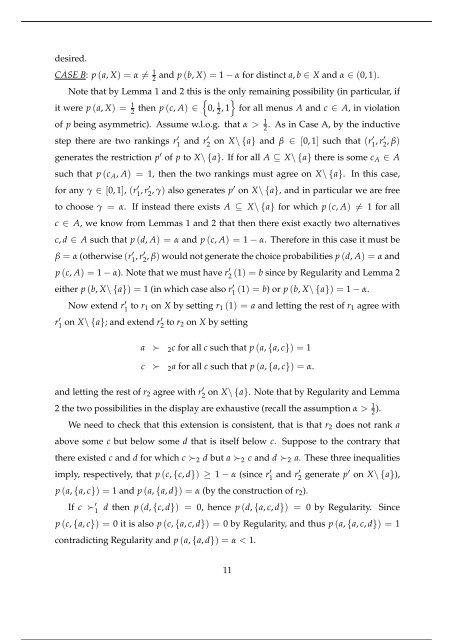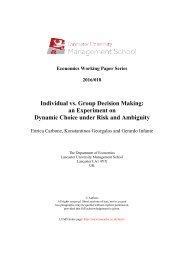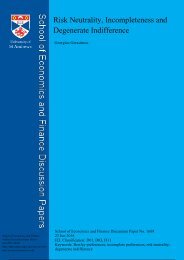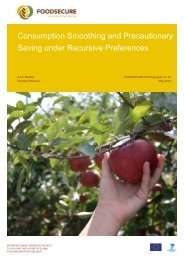Dual Random Utility Maximisation
n?u=RePEc:san:wpecon:1605&r=upt
n?u=RePEc:san:wpecon:1605&r=upt
Create successful ePaper yourself
Turn your PDF publications into a flip-book with our unique Google optimized e-Paper software.
desired.<br />
CASE B: p (a, X) = α ̸= 1 2<br />
and p (b, X) = 1 − α for distinct a, b ∈ X and α ∈ (0, 1).<br />
Note that by Lemma 1 and 2 this is the only remaining possibility (in particular, if<br />
{ }<br />
it were p (a, X) = 1 2 then p (c, A) ∈ 0,<br />
2 1, 1 for all menus A and c ∈ A, in violation<br />
of p being asymmetric). Assume w.l.o.g. that α > 1 2<br />
. As in Case A, by the inductive<br />
step there are two rankings r ′ 1 and r′ 2 on X\ {a} and β ∈ [0, 1] such that (r′ 1 , r′ 2 , β)<br />
generates the restriction p ′ of p to X\ {a}. If for all A ⊆ X\ {a} there is some c A ∈ A<br />
such that p (c A , A) = 1, then the two rankings must agree on X\ {a}. In this case,<br />
for any γ ∈ [0, 1], (r ′ 1 , r′ 2 , γ) also generates p′ on X\ {a}, and in particular we are free<br />
to choose γ = α. If instead there exists A ⊆ X\ {a} for which p (c, A) ̸= 1 for all<br />
c ∈ A, we know from Lemmas 1 and 2 that then there exist exactly two alternatives<br />
c, d ∈ A such that p (d, A) = α and p (c, A) = 1 − α. Therefore in this case it must be<br />
β = α (otherwise (r<br />
1 ′ , r′ 2<br />
, β) would not generate the choice probabilities p (d, A) = α and<br />
p (c, A) = 1 − α). Note that we must have r<br />
2 ′ (1) = b since by Regularity and Lemma 2<br />
either p (b, X\ {a}) = 1 (in which case also r<br />
1 ′ (1) = b) or p (b, X\ {a}) = 1 − α.<br />
Now extend r ′ 1 to r 1 on X by setting r 1 (1) = a and letting the rest of r 1 agree with<br />
r ′ 1 on X\ {a}; and extend r′ 2 to r 2 on X by setting<br />
a ≻ 2 c for all c such that p (a, {a, c}) = 1<br />
c ≻ 2 a for all c such that p (a, {a, c}) = α.<br />
and letting the rest of r 2 agree with r<br />
2 ′ on X\ {a}. Note that by Regularity and Lemma<br />
2 the two possibilities in the display are exhaustive (recall the assumption α > 1 2 ).<br />
We need to check that this extension is consistent, that is that r 2 does not rank a<br />
above some c but below some d that is itself below c. Suppose to the contrary that<br />
there existed c and d for which c ≻ 2 d but a ≻ 2 c and d ≻ 2 a. These three inequalities<br />
imply, respectively, that p (c, {c, d}) ≥ 1 − α (since r ′ 1 and r′ 2 generate p′ on X\ {a}),<br />
p (a, {a, c}) = 1 and p (a, {a, d}) = α (by the construction of r 2 ).<br />
If c ≻ ′ 1<br />
d then p (d, {c, d}) = 0, hence p (d, {a, c, d}) = 0 by Regularity. Since<br />
p (c, {a, c}) = 0 it is also p (c, {a, c, d}) = 0 by Regularity, and thus p (a, {a, c, d}) = 1<br />
contradicting Regularity and p (a, {a, d}) = α < 1.<br />
11






